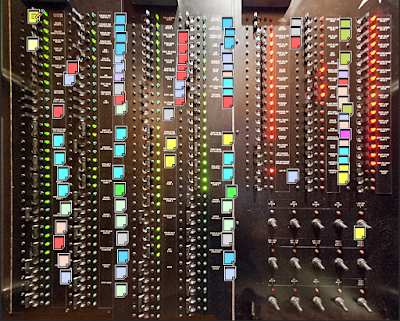Interestingly, Photoshop only imports PDF sticky notes, not text correction markups or drawing annotations. Acrobat does provide a somewhat helpful warning. "The PDF document contains annotation types that are not supported by Photoshop. These annotations will be ignored."
That message isn't completely clear in what it will do to your Acrobat PDF annotations. Photoshop will only display Sticky Notes; nothing else. Those are the only type of annotation that is interchangeable between Photoshop and Acrobat. The message would be more accurate if it said "deleted" instead of "ignored."
Let's explore the difference of Acrobat notes and Photoshop Notes, and see who one is better suited for which purpose. This is a photograph that requires me to use the Notes in both programs. This electrical panel has about 100 breaker labels, and I need to be able to easily find each one of them.
Here are my requirements for labeling all these breakers.
- So I need to label the breakers in a way that I can run a Find on them when I need to (because Acrobat can't successfully run OCR on this image).
- I need to be able to have the labels small, so they don't take up too much space and obscure my screen while I am labeling them.
- I need the labels color-coded.
Both Acrobat and Photoshop will allow me to do item #1 (label the breakers), but only Acrobat will allow me to run a Find on the labels.
 |
| Acrobat: Search Comments |
Photoshop can handle #2: labeling while keeping the labels small. It is a much better solution than Acrobat. See how large this comment is in Acrobat? It takes up way to much space! If you click on a comment in Acrobat, the giant pop-up note covers the page.
 |
| Comments in Acrobat obscure the image. |
The width of neither the Comments pane nor the sticky note pop-ups are changeable, so if you have both open, they take up a huge amount of screen real estate.
 |
| Acrobat Comment aligned to the edge of the page, with Commenting Pane open |
When viewing document, Acrobat centers your document in the window, giving you no ability to drag it over to the left a bit to free up some space on the right for the comments. See all that wasted gray space on the left?
 |
| All the gray space is wasted! |
Contrast this with Photoshop. When I click on a note, it doesn't automatically pop-up. The content simply displays in the Notes panel. Plus, I can drag the image over and fully utilize the entire window. The note icon is so small and elegant! Can you even find it in the image below? It doesn't obscure the image, and it's contents are displayed unobtrusively in the Notes pane, which I can either dock or drag wherever I want.
So Photoshop is definitely where I want to do my labeling.
Acrobat can handle item #3: color-coding. This is a very important part of my workflow, and I have written about it extensively. At first glance, Photoshop has no options for Notes. All you can do is navigate through the notes, delete them, or close the panel.
 |
| Photoshop Notes Panel |
 |
| Photoshop Character Panel |
For real customization of my notes, I have historically used Acrobat, because the user interface exists and is easy to find.
We've already discovered that Notes made on a Photoshop PDF in Acrobat. But one day, I happened to open in Photoshop a Photoshop PDF that I had color-coded in Acrobat. And guess what happened?!
 |
| Colored Notes in Photoshop! |
The notes were colored! It turns out that Photoshop has the ability to display different colors of notes! After using Photoshop notes for years, I recently discovered that when the Note tool is selected, the control bar displays two options: Author (which is blank by default), and Color. It is these two attributes that are interchangeable with Acrobat.
| Notes options in the Photoshop Control Bar |
The default behavior for attributes is different program to program. For example:
- InDesign: The default attributes of new objects are set when nothing is selected.
- Illustrator: The default attributes of new objects are picked up from the last object that you had selected.
- Acrobat: the default properties of new annotations are set when you choose "Make Properties Default."
In Photoshop, the default properties of new notes are more like Illustrator: they are picked up by whatever note you most recently had selected. Of course, you can also simply change the color in the Control bar. However, it's important to note that if you want to utilize Acrobat's Sort Comments By Color feature, the colors you choose need to match exactly. So rather than assigning all the Note colors using the Color Picker eyedropper, I prefer to simply either copy and paste the notes, and then change their content, or click on a note that is the color that I want, and then make a new note set to that color.
How to Sort and Search Notes
Once you've got your notes in Photoshop, it's time to head back over to Acrobat. But first, let's take a final look altho completely notated Photoshop document.
 |
| Photoshop PDF with Colored Notes |
Save your file as a Photoshop PDF, being sure to check the Notes checkbox.
Now open that file in Acrobat. The notes are color-coded and full searchable! Now I have all the functional that I need for my notes, but I didn't have to endure the overbearing and inflexible user interface of Acrobat commenting to create this.
 |
| Colored and Searchable Notes in Acrobat |






No comments :
Post a Comment